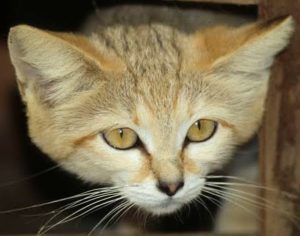 We’ve updated our Sand cat fact sheet with new information on their distribution and conservation threats.
We’ve updated our Sand cat fact sheet with new information on their distribution and conservation threats.
Distribution
Sand cats Felis margarita occur across the Sahara Desert, from Morocco in the west to as far as Egypt and the Sudan in the east. In Asia, they have been recorded in Syria, Iran, east of the Caspian Sea in Turkmenistan, Kazakhstan and Uzbekistan. Their presence in Pakistan is unknown. Sand Cats show a scattered distribution across the Arabian Peninsula but their status and distribution are not well known.
The global distribution of the Sand Cat appears to be markedly patchy. It is not clear whether the gaps in known range are due to a lack of records or truly reflect species absence.
Conservation
Habitat degradation and loss are considered to be the major threats to the Sand Cat. Vulnerable arid ecosystems are being rapidly converted by human settlement and activity, especially degraded through livestock grazing. Additional threats are the introduction of feral and domestic dogs and cats, creating direct competition for prey, predation and disease transmission. This applies particularly along roads through suitable habitat.
In Iran, Sand Cats are killed by shepherd dogs and trapped in snares set for other species. They also get stuck in fences and are vulnerable to indiscriminate trapping and poisoning of predators.
In the Arabian Peninsula, sand dune habitat continues to decline. Several of the areas have been affected by political strife, and war-like conditions that have accelerated habitat destruction i.e. Syria.
Locally, Sand Cats may be threatened by the pet trade. There are occasional reports of Sand Cats being shot in Saudi Arabia.
In Algeria, they are not considered a threat to poultry, or trapped to sell as pets. Toubou nomads living northwest of Lake Chad consider Sand Cats frequent chicken thieves which readily enter their camp in the evenings. They do not generally retaliate, due to traditional religious respect for these small cats as tradition holds that they were the companions of the Prophet Mohammed and his daughter.
The development of reliable survey methods is urgently needed to assess the population. Furthermore, studies on the behaviour and ecology of the Sand Cat are crucial to apply appropriate conservation measures.